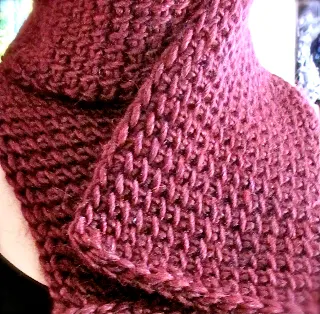2018 Update: I revised this popular post and created a permanent page for it at my new website.
 |
| Eilanner is a fancier variation of the Islander Wrap. Both are exceptions to Rule #2 below! |
Why? Because:
Standards in Tunisian crochet pattern writing are less developed than non-Tunisian crochet standards. I hadn't noticed this until I began publishing my own Tunisian crochet patterns. For non-Tunisian crochet, I head over to the industry's official yarnstandards.com and usually find everything I need, from yarn weight descriptions to skill levels and crochet stitch symbols. I feel confident that other professional crochet designers are using the same site as they write their patterns too. This helps all crocheters.
 |
| Five Peaks Wrap ©Interweave Press |
Example, pictured at right: When the Five Peaks Wrap was published in the Spring 2010 issue of Interweave Crochet magazine, it was rated Easy. It is 90% Tunisian Simple Stitch (the beginner's stitch), and in most of the rows, you do the same thing over and over. However, it is such a different experience of Tunisian crochet that in retrospect I think it should have been rated Intermediate.
I'm also finding out as I teach classes locally that the best way to arrange the sections of a Tunisian crochet pattern, and how certain things are explained, differ from what works for non-Tunisian crochet patterns.
Unless the only thing going on is Tunisian simple stitch, crocheters struggle more if the list of Tunisian pattern abbreviations is on a separate page. (It requires one to flip back and forth between pattern and abbreviations list.) They are also prone to forgetting at least one of the five rules, below.
The Top Five Rules to Know for Every Tunisian Crochet Pattern
How many of these do you always remember, even if they're not explicitly stated in an Intermediate-level Tunisian crochet pattern?
 |
| Intriguing exception to Rule #2. |
2. The fronts of your stitches face you at all times; you do not turn your work at the end of a Forward Pass or Return Pass. (Unless specifically instructed to.)
3. The single loop on the hook at the beginning of every Forward Pass counts as the first stitch of the new row. You do not chain to begin a new row. You also do not work into the very first stitch along that beginning edge of the row (Unless specifically instructed to, such as when you wish to increase stitches.)
 |
| Burly Bias: fun, easy exception to Rule #3. |
5. A Tunisian stitch is composed of a front vertical bar, a back vertical bar, and 3 horizontal bars located at the top of the 2 vertical bars.
Imagine what this means: you can work into not only 1 of 5 different loops of a stitch, but any combination of these 5....or into the space between two stitches....
Do you have one to add to this list?













